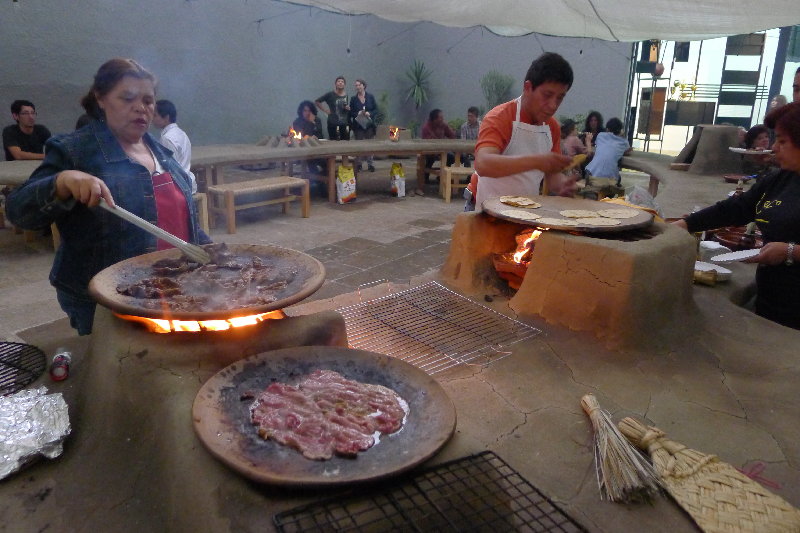The Museo Experimental El Eco in Mexico City states that for his project Nuestra Casa Sería un Campamento or “Our Home is a Camp,” Diego Pérez constructed a large kitchen sculpture in the museum’s courtyard.
The exhibition, which ran in the late summer of 2013, generated what the museum calls “collective” activities based around eating. Pérez was inspired by kilns customary on the coast of Guerrero and he saw an opportunity to make art which had a pragmatic function: to “ensure coexistence.” The artist said that he’s interested in humanity’s salvation, not by any theological agent, but through food.
This table is art which reached its fullest potential by encouraging people to use it. Pérez provided the foundation, but he needed it to be augmented through the work and energies of his audience, which in this case were cooks, diners or anyone looking to contribute to this pop-up community.
The museum included an essay by Mauricio Marcin which accompanied the work. We found a rough translation of that essay at Pablo Leon De La Barra’s blog at CentrefortheAestheticRevolution.blogspot.com. We’re including it here.
Our lives runs through in the illusion of time. These, are sustained in dieting and breathing.
Even though there have been diverse vegan movements —still fledgling fads— our times are omnivoruous: we eat everything.Generally, mankind is still the wolf of mankind. Progress is the most savage wolf; he eats the good savage and the developing third-worlder. There are those who don’t want any development. Diogenes, for example, ate raw octopus and died in consequence. He rejected Prometheus, who stole the fire of the gods to bring it to mankind, who use it to burn meat and food: the cooking pot and the casserole pot.
Contrary to Diogenes, we decided to be part –ashamed or not– of human kind. And we can congratulate ourselves of what the opposable thumb started. Or not. To who declares: “Living is bad”; we can suggest: “No, living bad…”
The building of the Chimney
After long trips to the Barra de Coyuca in Guerrero, Diego Perez decided to move two tons of clay and sand all the way to the Museo Experimental El Eco’s patio. What for? To create a communal kitchen and a temporary hearth. The word in Spanish for hearth, hogar, comes from the Latin focus, which is the root for the Spanish word fuego (fire). It’s common knowledge that a bonfire was maintained whenever possible.
The table-kitchen, beside the exhibition of objects, works for various purposes that the museum provides. El Eco is a vessel that assumes and facilitates actions. The table is –in its own way– the same. It was made to be used; for it to host pleasure and intelligence.
Description of the transformations
One side of Barra de Coyuca is beaten endlessly by the open sea, the other is tampered by the soft waves of a lagoon. Reynold lives in the middle of both waters: fisherman, cook, family man. Reynold brings his cousin José Luis to put him in charge of taking out the clay from the lagoon’s floor.
The clay that lays a half meter under water is perfect for modeling.
It’s the same clay that the inhabitants of Coyuca (and the rest of the Guerrero coastline) use to build their chimneys to cook their food. This stove building technique has been passed on from one generation to the next; with little variations, but still current. Diego Pérez learned this technique from these people to duplicate it in Mexico City.
An elliptic chimney
In order to build the table, besides the Coyuca native technique, Perez alluded to Mathias Goertiz aesthetics. The satellite towers are the foundation of a griddle. Perez’s work implies an ethical aesthetic; its an object of knowledge and use. Contrary to the idea that it is useful because it’s beautiful, we could say that his table is beautiful because it’s useful.
We don’t know what will happen around it. A “pescado a la talla” is to be expected, “tortillas” in the griddle are expected, and also diners.
For this city “that is a waste land,” Pérez built something similar to a garden or a shelter, a public and living place. You may bring charcoal or wood, or a book; you can take care of this place and think about Montaigne’s proposal: Our most petty and glorious masterpiece is living as it should be.
Above image: Diego Pérez, Nuestra Casa Sería un Campamento at the Museo Experimental El Eco in Mexico City, 2013. Photograph from Centre for the Aesthetic Revolution.










Diego Pérez, Nuestra Casa Sería un Campamento at the Museo Experimental El Eco in Mexico City, 2013. Photographs from Centre for the Aesthetic Revolution.
Visit the Museo Experimental El Eco
Visit Centre for the Aesthetic Revolution

Add your valued opinion to this post.